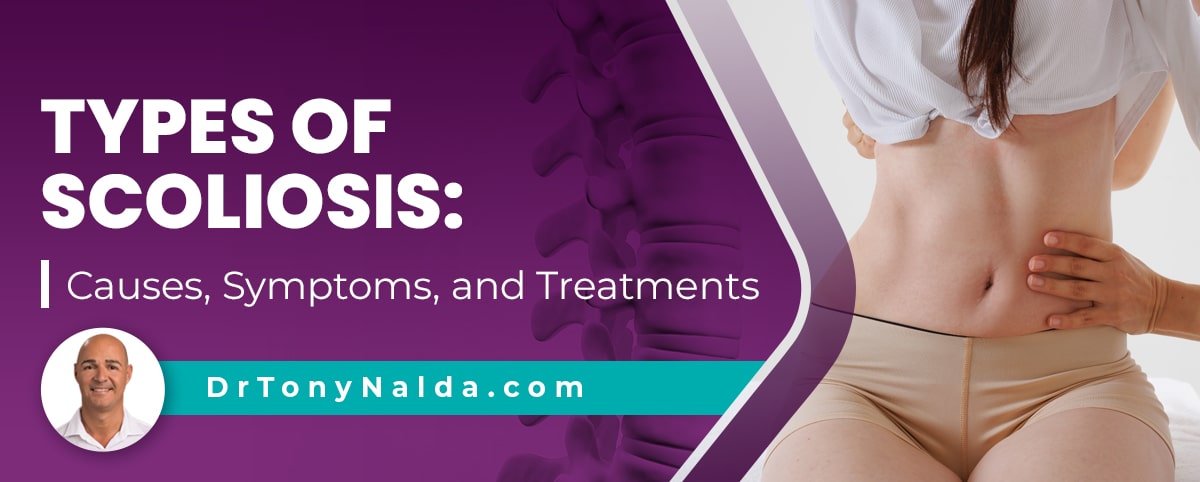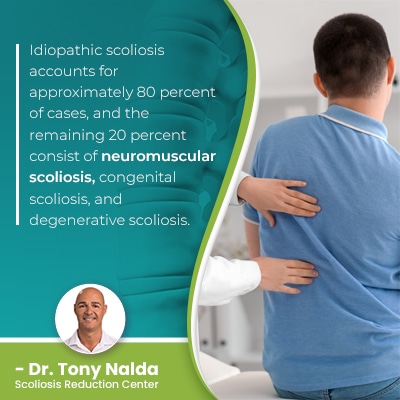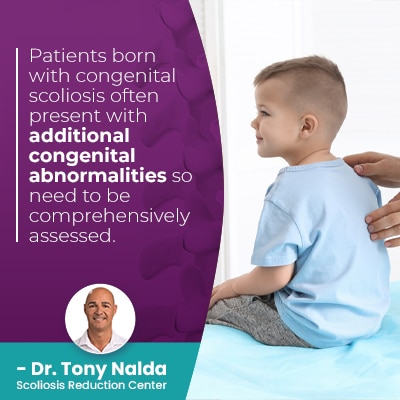Types of Scoliosis: Causes, Symptoms, and Treatments

Different types of scoliosis have unique causes, symptoms, and treatment needs. From typical scoliosis cases with spinal curves that bend to the right and atypical scoliosis cases with curves that bend to the left, no two cases are the same, necessitating the customization of treatment plans.
Idiopathic scoliosis has no known cause and accounts for approximately 80 percent of known cases, and the remaining 20 percent are associated with known causes: neuromuscular scoliosis, congenital scoliosis, and degenerative scoliosis.
A number of variables shape the crafting of treatment plans, one of which is condition type, so let's start with exploring the four main types of scoliosis.
Table of Contents
The Four Main Types of Scoliosis
Scoliosis diagnosed means an unnatural spinal curve that bends to the side and twists has developed, and as a progressive condition, the nature of scoliosis is to get worse over time.
With current estimates at close to seven million people living with the condition in the United States alone, scoliosis awareness is important; it's also the leading spinal condition among school-aged children.
We don't always know what causes scoliosis to develop initially, but we know it's growth that triggers it to get worse, and scoliosis gets more complex to treat the more severe it becomes.
Scoliosis can be treated surgically or nonsurgically, and it's important for patients to understand what different treatment options have to offer because they shape long-term spinal health and function: important for quality of life.
Scoliosis is diagnosed through a combined physical examination that includes taking patients' family history and medical history; scoliosis isn't a genetic condition, but it is considered familial so having scoliosis in the family is a risk factor.
A physical examination involves looking at the spine while in a forward bend position, and an X-ray is needed to confirm what's really happening to the spine, confirm the condition's rotational component, and to determine the patient's Cobb angle measurement.
A patient's Cobb angle is determined during X-ray and tells me how far out of alignment the spine is and how severe a patient's scoliosis is; the higher a patient's Cobb angle, the more severe the condition.
Condition type is determined by causation, and the most prevalent type of scoliosis is idiopathic.
Idiopathic scoliosis
 The main type of scoliosis to affect all ages is idiopathic scoliosis, and idiopathic means not clearly associated with a single-known cause.
The main type of scoliosis to affect all ages is idiopathic scoliosis, and idiopathic means not clearly associated with a single-known cause.
Idiopathic scoliosis is thought to be multifactorial, meaning caused by a number of factors, or a combination of them, that can vary from person to person.
Idiopathic scoliosis accounts for approximately 80 percent of cases, and the remaining 20 percent consist of neuromuscular scoliosis, congenital scoliosis, and degenerative scoliosis.
The 20 percent with known causes are considered atypical types of scoliosis.
Adolescent Idiopathic Scoliosis
The most prevalent type of scoliosis overall is adolescent idiopathic scoliosis diagnosed between the ages of 10 and 18, and if this is left undiagnosed and untreated in adolescence, it becomes idiopathic scoliosis in adults.
In adolescents, the main symptoms of scoliosis involve postural changes caused by the condition disrupting the body's symmetry, and these types of changes can involve:
- Uneven shoulders
- Uneven shoulder blades
- The development of a rib cage arch
- Uneven hips
- Arms and legs that hang at different lengths
- Ill-fitting clothing
Disruptions to balance, coordination, and gait are also common.
The main symptom of idiopathic scoliosis in adults is pain because the condition becomes compressive once skeletal maturity has been reached, which is why so many cases of adolescent idiopathic scoliosis progress into adulthood and aren't noticed until they become painful.
Compression (uneven pressure) of the spine and its surrounding muscles and nerves is the main cause of condition-related pain.
For young patients who are still growing, the constant lengthening motion of growth counteracts the compressive force of the unnatural spinal curve.
Idiopathic scoliosis is considered typical because it involves an unnatural spinal curve that bends to the right, away from the heart (dextroscoliosis), while atypical types of scoliosis can feature curves that bend to the left, towards the heart (levoscoliosis).
Neuromuscular Scoliosis
Neuromuscular scoliosis (NMS) patients are among my most severe cases because their scoliosis is caused by the presence of a larger neuromuscular condition like spina bifida, muscular dystrophy, or cerebral palsy.
These neuromuscular conditions cause a disconnect between the brain, the spine, and the muscles and/or connective tissues that support the spine.
Condition severity is determined by the degree of nerve involvement and nerve damage.
Because a larger medical condition has caused the development of scoliosis, the underlying neuromuscular condition has to be the focus of treatment, complicating the process.
My NMS patients can be challenging to treat; they are often severe and very severe scoliosis cases with some patients becoming wheelchair bound and unable to walk on their own.
Symptoms of NMS can include back pain, leg pain, radiating pain, muscular imbalance, movement issues, postural changes, and a number of sensations caused by nerve damage.
Unnatural spinal curvatures caused by a larger neuromuscular condition are more likely to progress rapidly, so symptoms of NMS can escalate quickly.
Congenital Scoliosis
 Congenital scoliosis is diagnosed in babies who are born with the condition due to a malformed spine that develops in utero.
Congenital scoliosis is diagnosed in babies who are born with the condition due to a malformed spine that develops in utero.
Patients born with congenital scoliosis often present with additional congenital abnormalities so need to be comprehensively assessed.
Spinal malformations can involve the vertebrae (bones of the spine) failing to form into distinct and separate vertebral bodies and instead becoming fused together and/or vertebrae being misshapen and making it difficult for the spine to form in alignment.
Symptoms of congenital scoliosis can include a visibly misshapen spine that gets worse with growth; progression is triggered by growth spurts.
Congenital scoliosis is a rare type, affecting approximately 1 in 10,000; obviously, there are challenges associated with treating conditions in patients of such a young age so plans need to be modified, can include observation, physical therapy, and bracing when older.
However, some cases of congenital scoliosis can be severe and require surgical intervention.
Degenerative Scoliosis
Degenerative scoliosis most often affects older adults and is caused by a natural age-related degenerative process.
The body is subject to degenerative changes over time, and the spine is no exception.
When it comes to spinal degeneration, the first spinal structures to be affected are often the intervertebral discs that sit between adjacent vertebral bodies.
The discs give the spine structure, flexibility, provide cushioning to prevent friction, and act as the spine's shock absorbers.
When a disc degenerates, it tends to lose height and change shape, and this affects the position of adjacent vertebrae attached, disrupting the spine's ability to maintain its healthy curves and alignment.
Degenerative scoliosis is most common in adults over the age of 50 and is more common in females due to changes in hormones and bone density related to menopause.
Symptoms of degenerative scoliosis can include postural changes and increasing back pain as the spine becomes more unstable and unbalanced over time.
Treatment needs are about improving the spine's stability, preventing further degeneration, and reducing the curve size back to where it was prior to becoming painful.
Conclusion
Deciding how to treat scoliosis is the most important decision to be made following a diagnosis because different treatment options produce different results.
Here at the Scoliosis Reduction Center®, my patients benefit from a proactive conservative treatment approach that works towards preventing progression, increasing condition effects, and the need for invasive surgical treatment.
While surgical intervention still has a place in scoliosis treatment, the reality is that many cases of scoliosis don't require surgical intervention, particularly with early diagnosis and intervention.
By combining condition-specific chiropractic care, physical therapy, scoliosis exercises, corrective bracing, and rehabilitation, conditions can be impacted on every level.
While there are never treatment guarantees, with early detection and intervention, scoliosis can be highly treatable, and curve progression can be prevented and common symptoms addressed.
Scoliosis can affect all ages as congenital scoliosis, infantile scoliosis, juvenile scoliosis, adolescent scoliosis, and adult scoliosis diagnosed once skeletal maturity has been reached.
Severe curves are likely to continue progressing, hence the benefit of working towards preventing scoliosis from becoming severe; in most cases, it's more effective to proactively attempt to prevent progression and escalating symptoms than it is to attempt to reverse condition effects once they've developed and are established.
For young patients with significant growth remaining, there is more potential progression to go through, but the actual rate of scoliosis increases in the aging population, and this is due to age-related spinal degeneration.
So while there are different types of scoliosis, all can benefit from a proactive treatment approach.
Dr. Tony Nalda
DOCTOR OF CHIROPRACTIC
After receiving an undergraduate degree in psychology and his Doctorate of Chiropractic from Life University, Dr. Nalda settled in Celebration, Florida and proceeded to build one of Central Florida’s most successful chiropractic clinics.
His experience with patients suffering from scoliosis, and the confusion and frustration they faced, led him to seek a specialty in scoliosis care. In 2006 he completed his Intensive Care Certification from CLEAR Institute, a leading scoliosis educational and certification center.
About Dr. Tony Nalda
 Ready to explore scoliosis treatment? Contact Us Now
Ready to explore scoliosis treatment? Contact Us Now





